ICSE Class 10 students can refer to ICSE Class 10 Electrolysis Notes given below which have been prepared as per the latest syllabus and guidelines issued by ICSE Board. All chapter wise revision notes for ICSE Class 10 Chemistry have been prepared by teachers have strong understanding of Chemistry. Read the notes prior to the exams to get better marks in exams
Electrolysis ICSE Class 10 Chemistry Revision Notes
Students can refer to the quick revision notes prepared for Chapter Electrolysis in Class 10 ICSE. These notes will be really helpful for the students giving the Chemistry exam in ICSE Class 10. Our teachers have prepared these concept notes based on the latest ICSE syllabus and ICSE books issued for the current academic year.
Revision Notes ICSE Class 10 Chemistry Electrolysis
Please refer to the detailed notes below
Electrolysis
It is the process of decomposition of a chemical compound in aqueous solution or in a molten state,
accompanied by a chemical change using direct current.
Electrolyte
It is an ionic compound which in the fused state or in the aqueous solution allows the passage of an
electric current and is decomposed by it.
Strong Electrolytes
The compounds which in their aqueous solution or in the fused state are almost completely ionised are
called strong electrolytes.
Examples: Mineral acids, alkalis and salts
Weak Electrolytes
The compounds which in their fused state or aqueous solution are feebly ionised and are poor conductors
of electricity are called weak electrolytes.
Examples: Acetic acid, oxalic acid
Non-electrolytes
The compounds which neither in solution nor in the molten state allow an electric current to pass through
them are called non-electrolytes.
Examples: Kerosene, carbon disulphide
Electrolytic Cell
It is a device used to convert electrical energy into chemical energy.
Electrochemical Cell
It is a device used to convert chemical energy into electrical energy.
Electrodes
The graphite, metal plates or gas carbon rods immersed in the electrolyte through which current enters
and leaves the electrolytic cell are called electrodes.
Cathode
The electrode connected to the negative terminal of the battery is called a cathode.
Anode
The electrode connected to the positive terminal of the battery is called an anode.
Ions
The atoms or groups of atoms which carry a positive or negative charge are known as ions.
Cations
Atoms which carry a positive charge are called cations.
Anions
Atoms which carry a negative charge are called anions.
Oxidation
It is a chemical process which involves the addition of oxygen or the removal of hydrogen.
Oxidising Agents
It is a substance which oxidises other substances either by accepting electrons or by providing oxygen or
an electronegative ion.
Reduction
It is a chemical process which involves the removal of oxygen or the addition of hydrogen.
Reducing Agent
It is a substance which reduces other substances by providing electrons, hydrogen or an electropositive
ion.
Dissociation
The process due to which an ionic compound dissociates into ions in the fused state or in the aqueous
solution is called electrolytic dissociation.
Example: Electrovalent compound such as NaCl.
NaCl → Na+ + Cl–
Ionisation
The process by which polar covalent compounds are converted into ions in water solution is called
ionisation

Electrochemical Series
It is a series in which metals are arranged based on the ease with which atoms of metals lose electrons to
form positively charged ions.

Selective Discharge of Ions
The preferential discharge of ions present in an electrolyte at the respective electrodes is known as
selective discharge of ions.
It depends on the following factors:
i. Relative position of ions in an electrochemical series
ii. Concentration of the ions
iii. Nature of the electrode
Electrolysis of Fused Lead Bromide
Electrolyte: Molten lead bromide (PbBr2)

Electrolysis of Acidified Water
Electrolyte: Acidified water


Ions present: H+, SO42–, OH–
Reaction at the cathode: H+ + e –→ H
H + H→ H2 (Hydrogen molecule)
Reaction at the anode: OH– − e− → OH × 4
OH– ion discharge in preference to SO42–
4OH→ 2H2O + O2 (Oxygen molecule)
Electrolysis of Aqueous Copper Sulphate
Electrolyte: Aqueous copper sulphate solution

Reaction at the cathode: Cu2+ + 2e− → Cu
Cu being lower in the electrochemical series.
Reaction at the anode: Cu − 2e– → Cu2+ SO4 2–
and OH– are not discharged.
Applications of Electrolysis
i. Electroplating with metals
ii. Electrorefining of metals
iii. Extraction of metals
Electroplating
It is a process in which a thin film of a metal, such as gold, silver or nickel, gets deposited on another
metallic article with the help of electricity.
Reasons for Electroplating
i. Decoration purposes
ii. To protect from rusting and corrosion
Electroplating with Nickel
Electrolyte: Aqueous solution of nickel sulphate

Cathode: Article to be electroplated
Anode: Block of pure nickel
Reaction at cathode: Ni2+ + 2e−→ Ni (deposited)
Reaction at anode: Ni − 2e−→ Ni2+
Note: Article to be electroplated is always kept at the cathode.
Electrolytic refining of metals
It is a process by which metals containing impurities are purified electrolytically to give a pure metal.
Electrolytic refining of copper
Electrolyte: Copper sulphate solution and dil. sulphuric acid
Cathode: Thin strip of pure copper
Anode: Impure copper
Reaction at cathode: Cu2+ + 2e−→ Cu
Reaction at anode: Cu − 2e− → Cu2+
Electrometallurgy
It is the process of extraction of metals by electrolysis.

Acids, Bases and Salts as Electrolytes
They can be classified as strong or weak electrolytes depending on the degree of dissociation.

Electrolysis
An ionic compound or electrovalent compound is formed when metallic atoms donate electrons and non-metallic ions accept electrons.
The word electrolysis is made up of two words electro, which means the flow of electrons, and lysis, which means pertaining to.
Electrolysis is the process by which a chemical compound in the fused state or in aqueous solution undergoes a chemical change on the passage of current.
During electrolysis, a chemical change is brought about by electric energy.

• Electrolytic cell or voltameter is the vessel consisting of glass, containing two electrodes and an electrolyte.

• The graphite or metal rods through which electric current enters or leaves from an electrolyte are called electrodes.
Therefore, a cathode is the electrode which is connected to the negative terminal of the battery. It has an excess of electrons. An anode is than electrode which is connected to positive terminal of battery. It has deficiency of electrons
Difference between cathode and anode

Differences between metallic and electrolytic conductors

• Electrolyte refers to the compound, which in fused state or in aqueous state conducts electric current so that chemical decomposition of the compound takes place.
The electrolytes which allow a large amount of current to flow through them are called strong electrolytes. The strong electrolytes in fused state are completely dissociated and hence, their ions are free to move in any direction.
Examples include an aqueous solution of mineral acid and caustic alkalis.
The electrolytes which allow a very small amount of current to flow through them are called weak electrolytes. The strong electrolytes in fused state are completely dissociated. Hence, their ions are free to move in any direction.
Examples include aqueous solution of acid and bases.
• Non-electrolyte is the chemical compound which does not conduct electric current in fused state or in aqueous solution and does not undergo any chemical decomposition.
Examples are carbon tetrachloride, alcohol, ether, pure water, etc.
Differences between strong and weak electrolytes

• Ions
When a chemical compound in fused state or in aqueous solution breaks up into electrically charged atoms or group of atoms, the charged particles are called ions. A positively charged ion is cation. They migrate towards cathode. A negatively charged ion is an anion. They migrate towards anode.
Differences between cation and anion

Mechanism of electrolysis
It was put forward by Avante Arrhenius, a Swedish chemist. Following are the points given in his theory of electrolytic dissociation.
• An electrolyte is a substance which in an aqueous solution breaks into positively charged cations and negatively charged anions.
• The movement of ions within the electrolyte is responsible for the flow of electric current.
• The degree of dissociation refers to the extent to which electrolyte dissociates into ions.
• Cations and anions unite to form neutral ion, setting up equilibrium.
• An electrolyte is electrically neutral
Electrolysis of water:
Add a small amount of salt to water and pour this solution into a beaker. Connect two electrical wires to the terminal of the battery as shown in the figure. The two ends of the wires will serve as electrodes when the insulating cladding is removed from them. Take two test tubes and fill them with the solution of salt and water. Invert these test tubes on the electrodes and restrict the formation of air bubbles. Switch on the power supply.

Observe the two test tubes when the electric current is passed through it. The volume of the gas formed in one test tube is double than that of the gas formed in the other test tube.
The gas formed at the cathode is hydrogen while the gas formed at the anode is oxygen.
Cathode: 2H2O (l) + 2e– → H2 (g) + 2OH– (aq)
Anode: 2H2O (l) → O2 (g) + 4H+ (aq) + 4e–
Characteristics of electrolysis
• On passing the electric current, cations migrate towards cathode while the anions migrate towards the anode.
• The number of electrons accepted by an anode is equal to the number of electrons donated by the cathode.
• The products of electrolysis are formed on the surface of the cathode where the exchange of electrons occurs.
• The preferential discharge of ions depends upon their position in electrochemical series and the concentration of ions.
• Neutral atoms of metals and hydrogen are liberated at the cathode. Therefore, they are called electropositive elements. Neutral atoms of non-metals are liberated at the anode. Therefore, they are called electronegative elements. • According to Faraday’s law of electrolysis, the mass of a substance discharged at an electrode is directly proportional to the quantity of electricity passing through the electrolyte.
• Direct current is suitable to carry out electrolysis.
• Electrolysis is a redox reaction, where reduction occurs at cathode and oxidation occurs at anode.
Do you know solid ionic compounds do not conduct electricity while fused ionic compound and aqueous solution do?
This happens because the electric current passes through an ionic compound only if it has free ions for migration. In a solid ionic compound, ions are held together by strong electrostatic forces. Hence, the ions are not free to migrate. Therefore, solid ionic compounds do not conduct electricity. But fused ionic compound and an aqueous solution of a compound have free ions produced by electrolytic dissociation of the ionic compound. These ions are free to conduct electricity.
Let us study it with the help of some examples.
Example- Solid ionic lead bromide does not conduct electricity as lead ions and bromide ions are not free to migrate. This is because they are held together by strong electrostatic forces.

But when lead bromide is heated, ions gain kinetic energy. At one point, ions have more kinetic energy than the electrostatic bonds holding them and they start moving freely. Hence, the fused compound conducts electricity.

In an aqueous solution of compounds, say lead bromide, the slight positive charge on hydrogen atom pulls the bromine ions and slight negative charge on oxygen atom pulls the lead ions. This weakens the electrostatic attraction between lead and bromide ions. Thus, free ions are migrated towards cathode and anode and thus, it conducts electricity.

Also, covalent compounds such as molten wax or kerosene oil do not conduct electricity as they do not produce free ions even on heating or in solution form. However, there are
certain covalent compounds that form ions when dissolved in water and thus conduct electricity.
The process of conversion of polar covalent compounds into ions in aqueous solution is known as ionisation. For example, pure hydrogen chloride does not contain any ion. It does not conduct electricity.
However, due to the difference in the electronegativities of H and Cl, there exists a small charge distribution, making it a polar covalent compound. Addition of this pure hydrogen chloride to water helps in charge separation causing the formation of ions in the solution.

Electrochemical Series
Depending on the ease with which metals lose or gain electrons to form ions, they are arranged in a vertical column called electrochemical series.
Electropositive series
Depending on the ease with which metals lose electrons to form ions, they are arranged in a vertical column called electropositive series.
Metals, which ionise very easily such as potassium, are placed at the top of electropositive series. The cations formed are not discharged easily during electrolysis.
Metals, which do not ionise easily such as silver ion, are placed at the bottom of electropositive series. The cations formed are discharged very easily during electrolysis.
Electronegative series
Depending on the ease with which non-metals or group of non-metals gain electrons to form ions, they are arranged in a vertical column called electronegative series.
Non-metals or group of non-metals, which accept electrons very easily such as fluorine, are placed at the top of electronegative series. The anions formed are not discharged easily during electrolysis.
Non-metals or group of non-metals, which do not accept electrons easily such as hydroxyl ion, are placed at the bottom of electronegative series. The cations formed are discharged with very difficulty during electrolysis.

Selective discharge of ions
It refers to the preferential discharge of one particular cation at cathode and one particular anion at anode when an electrolyte contains two or more anions or cations.
Let us study the factors which influence selective discharge of ions.
• Relative positions of cations and anions in electrochemical series
Ions which are present at lower position in the electrochemical series have greater tendency of their discharge at respective electrode to form an element.
For example, in an electrolyte containing silver ion and hydrogen ion, both will migrate to cathode, but silver ions are discharged preferentially due to its lower position in electrochemical series.
In an electrolyte containing chloride ion and hydroxyl ion, both will migrate to cathode, but hydroxyl ions are discharged preferentially due to its lower position in electrochemical series.
• Concentration of ions
Higher the concentration, greater are the chances of their discharge on respective electrodes.
• Nature of anode
The selective discharge of anions migrating towards anode depends of the nature of anode. The anode can be chemically inert such as iron, graphite, etc. or chemically attackable such as nickel, silver, etc.
Electrolysis of some Common Electrolytes
Electrolysis of lead bromide
It is carried out under following conditions:
• Electrolytic cell – Silica crucible, containing fused lead bromide and graphite electrodes, is used as it is non-reactive and a bad conductor of electricity.
• Electrolyte – Molten fused lead bromide is used as solid lead bromide is a bad conductor of electricity while molten fused lead bromide is a good conductor of electricity.
• Electrodes – Inert electrodes are used because they do not react with the products formed. Graphite is used as cathode and anode in preference to platinum because bromine evolved at anode can react with platinum.
• Temperature – A temperature of 380ºC or above is maintained by external heating, which is the melting point of lead bromide.
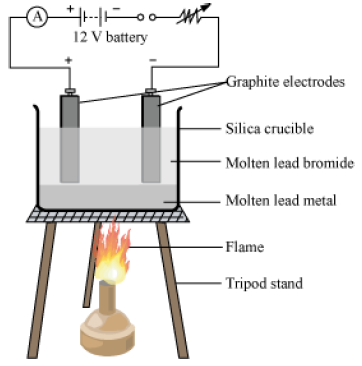
• Dissociation of electrolyte

Lead ions and bromide ions are formed in the process.
On passage of electric current, lead ions are attracted towards cathode while bromide ions migrate towards anode.
At cathode
Cathode acts as electron donor. Therefore, the following reaction takes place.

Lead metal is formed at cathode, which settles down at the base of crucible.
At anode
Anode acts as electron acceptor. Therefore, the following reaction takes place.

Therefore, bromine vapours are formed at anode.
Electrolysis of acidulated water
It is carried out under the following conditions:
• Electrolytic cell – Hofmann’s voltameter is used. It consists of three interconnected glass tubes. The central tube is used for pouring acidulated water while products are collected from side tubes.
• Electrolyte − Distilled water containing 2% sulphuric acid is used. Sulphuric acid is used because it helps in dissociation of water.
• Electrodes – Inert electrodes are used because they do not react with the products formed. Platinum strip is used as cathode and anode because the products formed at anode do not react with platinum.
• Temperature – The electrolysis is carried out at room temperature.

• Dissociation of electrolyte

On passage of electric current, H+ ions are attracted towards cathode while OH+ and SO42-ions migrate towards anode
At cathode
Cathode acts as electron donor. Therefore, the following reaction takes place.
H+ E– → H ] X 4
2H + 2H → 2H2
Hydrogen atoms are formed at cathode.
At anode
Anode acts as an electron acceptor. Therefore, the following reaction takes place.
OH– → OH + E– ] X 4
4 OH → 2H2O + O2
Hence, oxygen gas is liberated at anode.
Electrolysis of aqueous acidulated copper sulphate solution using copper sulphate-
It is carried out under the following conditions:
• Electrolytic cell – A glass container is used as it is a bad conductor of electricity. It contains saturated copper sulphate solution and two copper electrodes.
• Electrolyte − Saturated aqueous copper sulphate solution acidified with sulphuric acid is used. It is acidified to prevent hydrolysis of copper sulphate.
• Electrodes – Inert electrodes are used because they do not react with the products formed. Copper plate or copper rod is used as cathode and anode.
• Temperature – The electrolysis is carried out at room temperature.
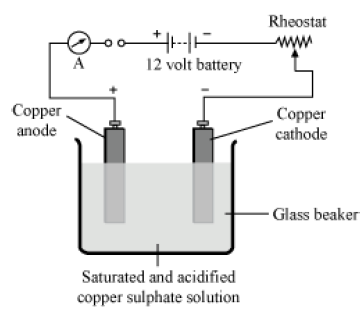
• Dissociation of electrolyte
H2O ↔ H+ + OH–
H2SO4 ↔ 2H+ + SO42-
CUSO4 ↔ CU2+ + SO42-
On the passage of electric current, H+ and CU2+ ions are attracted towards cathode while OH– and SO42- ions migrate towards anode.
At cathode
Cathode acts as electron donor. Therefore, the following reaction takes place.
Cu2+ + 2e– → Cu
Copper metal is formed at cathode.
At anode
Anode acts as an electron acceptor. Therefore, the following reaction takes place.
Cu – 2e– → Cu2+
The concentration of Cu2+ ions does not change. It is because the number of ions deposited at the cathode is equal to the number of copper atoms, which ionise at the anode.
Electrolysis of aqueous acidulated copper sulphate solution using platinum anode and copper or platinum cathode
It is carried out under the following conditions:
• Electrolytic cell – A glass container is used as it is a bad conductor of electricity. It contains saturated copper sulphate solution and platinum or copper electrodes.
• Electrolyte − Saturated aqueous copper sulphate solution acidified with sulphuric acid is used. It is acidified to prevent hydrolysis of copper sulphate.
• Electrodes – Inert electrodes are used because they do not react with the products formed. Copper plate or copper/platinum rod is used as cathode and platinum anode.
• Temperature – The electrolysis is carried out at room temperature.
• Dissociation of electrolyte
H2O ↔ H+ + OH–
H2SO4 ↔ 2H+ + SO42-
CuSO4 ↔ Cu2+ + SO42-
On passage of electric current, H+ and Cu2+ ions are attracted towards cathode while OH– and SO42– ions migrate towards anode.
At cathode
Cathode acts as electron donor. Therefore, the following reaction takes place.
Cu2+ + 2e– → Cu
Copper metal is formed at cathode.
At anode
Anode acts as electron acceptor. Since OH− ions are low in electrochemical series than SO42- ions, hence they will be discharged at anode to give off oxygen gas as shown below:
4 OH– — 4e_ →4 OH
2 OH + 2 OH → 2H2O + O2
Note: Once the electrolysis of copper sulphate is complete, then the electrolysis of water starts in and hydrogen gas is liberated at cathode, while oxygen is liberated at anode. Also, in this electrolysis the blue colour of the electrolyte fades away due to decrease in the concentration of Cu2+ ions.
Application of Electrolysis
Electrolysis is used for the following purposes:
• Electroplating
• Electro-refining
• Extraction of metals by electrolysis
Electroplating
The process of depositing a thin and compact layer of superior metal over the inferior metal by the process of electrolysis is called electroplating. It can be of many types such as silver plating and nickel plating
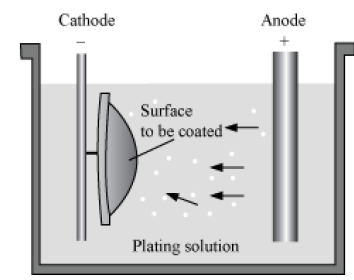
It is done for the following reasons:
• To prevent metallic articles
from rusting For example, articles made of iron are electroplated with nickel so as to prevent them from rusting.

• To improve appearance of articles
For example, decoration articles made from copper or brass are electroplated with silver to improve their appearance.
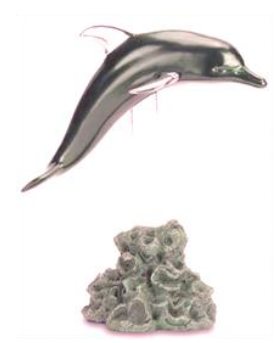
Conditions of electroplating
• Articles to be electroplated must be very clean.
• Articles to be electroplated are made cathode while the metal to be electroplated is made anode.
• The metal to be electroplated is to be replaced periodically as it is consumed.
• The electrolyte must be in the form of an aqueous saturated solution and it must contain ions of metals to be electroplated.
• The electrolyte must be acidulated with some acid containing negative ions so as to prevent hydrolysis.
• Low and direct current should be used so that the electrolyte is not heated up.
Let us study silver plating now.
The electrolyte used is the saturated aqueous solution of sodium argento cyanide acidified with hydrocyanic acid. A highly cleaned article is used as a cathode while a hollow cylinder of silver surrounding cathode is used as an anode.

Electrolyte dissociates as follows:
NaAG (CN)2 ↔ Na+ + Ag+ + 2CN–
HCN ↔ H+ + CN–
H2O ↔ H+ + OH–
At the cathode, silver ions discharge because of their low reduction potential.
Ag+ + e– → Ag
At the anode, silver atoms discharge to form silver ions because of their low reduction potential
Ag_ e– → Ag+
Let us study nickel plating now.
The electrolyte used is the saturated aqueous solution of nickel sulphate acidified with sulphuric acid. A highly cleaned article is used as a cathode while a hollow cylinder of nickel surrounding cathode is used as an anode.
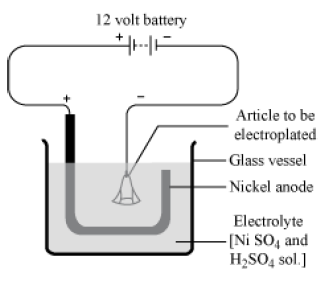
Electrolyte dissociates as follows:
NISO4 ↔ Ni2+ + SO42-
H2SO4 ↔ 2H+ + SO42-
H2O ↔ H+ + OH–
At the cathode, nickel ions discharge because of their low reduction potential
Ni2+ + 2e– → Ni
At the anode, nickel atoms discharge to form nickel ions because of their low reduction potential.
Ni _ 2e– → Ni2+
Electro-refining
Electro – refining is the process by which impurities are removed from an impure metal. Metals such as silver and copper are refined using electro-refining.
Let us study electro-refining of copper.
The electrolyte used is the saturated aqueous solution of copper sulphate acidified with sulphuric acid. Pure copper thin sheets connected in parallel are used as a cathode while impure copper thin sheets connected in parallel are used as an anode.
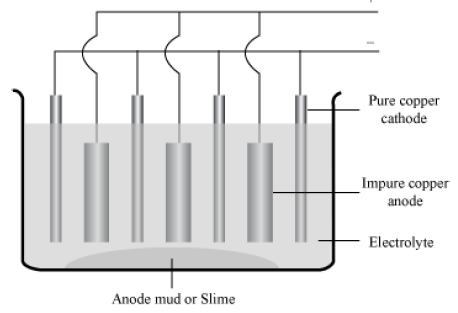
Electrolyte dissociates as follows:
CuSO4 ↔ Cu2+ + SO42-
H2SO ↔ 2H+ + OH42-
H2O ↔ H+ + OH–
At the cathode, copper ions discharge because of their low reduction potential.
Cu2+ + 2e– → Cu
At the anode, copper atoms discharge to form copper ions because of their low reduction potential.
Cu_ + e– → Cu2+
Let us watch an animation to understand better.
Electro-metallurgy
It refers to the process of extraction of metals from their fused ores by the process of electrolysis. This method is useful for extraction of reactive metals like potassium (K), sodium (Na), magnesium (Mg), etc. Halides of reactive metals are used as electrolytes and the electrodes are iron (as a cathode) and graphite (as an anode). The aqueous solution of reactive metals is not employed for the extraction process, as it contains H+ ions will be preferentially discharged on the cathode instead of metal ions.
The table given below explains the extraction of these reactive metals by electrolysis.

Ionisation of Acids and Bases
Arrhenius Concept
• Strong acids are those which completely dissociate in aqueous solutions to give H+ ions which form H3O+ ions.
• Examples: Perchloric acid (HClO4), hydrochloric acid (HCl), hydrobromic acid (HBr), hydroiodic acid (HI), sulphuric acid (H2SO4), nitric acid (HNO3)
• Strong bases are those which completely dissociate in aqueous solutions to give OH− ions.
• Examples: Lithium hydroxide (LiOH), sodium hydroxide (NaOH), potassium hydroxide (KOH), barium hydroxide (Ba(OH)2)
Bronsted-Lowry Concept
• The conjugate base of a strong acid is a weak base.

Strong acid Weak base
• The conjugate base of a weak acid is a strong base.

Weak acid Strong base
• The conjugate acid of a strong base is a weak acid.
CH3COOH(aq) + OH−(aq) ↔ H2O(l) + CH3COO−(aq)
Strong base Weak acid
• The conjugate acid of a weak base is a strong acid.
HCl(aq) + H2O(l) ↔ H3O+(aq) + Cl−(aq)
Weak base Strong acid
• Weaker the conjugate base, stronger is the acid. Similarly, weaker the conjugate acid, stronger is the base.
• Phenolphthalein and bromothymol blue
• Weak acids
• Exhibit different colours in their acid (HIn) and conjugate base (In−) forms.
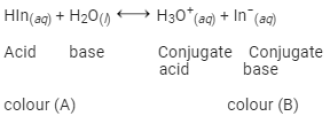
• Used as indicators in acid-base titration
Strong and Weak Electrolyte
1. Strong electrolyte: Electrolytes which ionise in water completely are termed as strong electrolytes such as NaCl, MgCl2 etc. Strong acids, strong bases, and soluble salts are strong electrolytes.
2. Weak electrolyte: Electrolytes which do not ionise completely in water are termed as weak electrolytes such as acetic acid. Weak acids, weak bases, and sparingly soluble salts are weak electrolytes.
Degree of Dissociation
When an electrolyte is dissolved in water or any solvent it may either completely dissociate or partially dissociate. Their solubility in a solvent such as water is expressed by the degree of dissociation.
It is defined as the extent to which an electrolyte dissociates into ions in a solvent. It is represented by the symbol α. It is calculated as follows

The value of α is 1 for strong electrolytes as they are completely dissociated and less than 1 for weak electrolytes since they are not completely dissociated
The value of α for an electrolyte depends on
(i) Nature of solvent: Solvent having a high dielectric constant will favour the dissociation.
(ii) Nature of electrolytes: Strong electrolytes dissociate completely while weak electrolyte dissociates partially.
(iii) Dilution: Increasing dilution will increase the degree of dissociation of weak electrolytes.
(iv) Temperature: Increase in temperature generally favours the dissociation.


